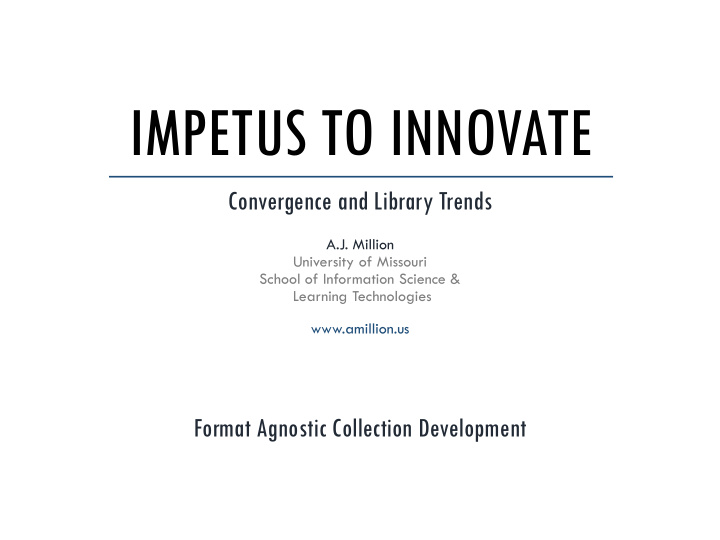



IMPETUS TO INNOVATE Convergence and Library Trends A.J. Million University of Missouri School of Information Science & Learning Technologies www.amillion.us Format Agnostic Collection Development
CHAPTER Million, A. & Moulaison, H. (2014). “Impetus to Innovate: Convergence and Library Trends.” In K. Varnum (Ed.), Top Technology Trends: A LITA Guide. Chicago: ALA Editions.
Source: desktop-wallpaper.net You can't beat the market because it’s smarter than you are. Intellectually, the only task is trying to determine what the market is telling you. – Robert Leroy Bartley
MEDIA THEORY Convergence is “the flow of content across multiple media platforms” (Jenkins, 2006, p. 282). It blurs “the lines between media […] such as the post, telephone and telegraph, and mass communication, such as the press, radio, and television” (Pool 1983, p. 23 as cited in Jenkins 2006, p. 10). LIBRARIES AND LIBRARIANS Our chapter defines convergence as “the coming together of analog and digital formats in the form of ones and zeros on computers.” Convergence has a different impact on librarianship than other media professions.
CONTENT AND CARRIERS Content is the information patrons want. One example is “Gone With The Wind” which can be found in print (paperback, hardback) or on film (VHS, DVD, HD- DVD, etc…). Carriers, on the other hand, are content platforms. Examples include books, television, and the Internet. These definitions don’t take into account format, utility, or usability. We defined everything to emphasize libraries instead of some of the questions media theorists ask.
Source: images4.fanpop.com What does this have to do with anything? I mean, it’s interesting, but why should I care? – Everyone Who Is Still Listening
NEEDS ARE A CHANGIN’ Information seekers satisfice (Prabha et al. 2007). Patrons don’t always care about the format a library opts to buy so long as they get what they want. The “long - tail” means demand for unique resources. Patrons also want simplicity. Is it possible to offer one-stop shop access? Is there too much information out there? Trends have encouraged convergence in the digital realm. Netflix, Amazon, and iTunes… Corporate centralization is driven by the convenience of big online subscriptions. Libraries don’t have the money to build these collections.
MARKET COMPETITION Companies have an incentive for their standard(s) to be adopted. We found high-profile examples of market competition that slow down standardization: Blu- ray (Sony) and HD-DVD (Toshiba); HMTL5 (Apple) and Flash (Adobe); and Internet Explorer (Microsoft) and Navigator (Netscape). CONVERGENCE CULTURE The democratization of media creation, thanks to the digital revolution, has allowed for an explosion of content. This has created what media theorists call convergence culture. Examples include Harry Potter fan-fiction and YouTube videos.
IMPLICATIONS Convergence is driven by digitization. As media becomes digital so does content. This allows for standards, but competition limits standard coexistence. A trend toward carrier convergence does not mean there is a trend toward format convergence. Libraries should push for open standards so users don’t have to satisfice. Libraries can also harness this trend and encourage the creation of content through maker- spaces. The Woodneath Library Center in Kansas City has a story center and maker-space for it’s patrons.
Source: jokesoftheday.net
CONCLUSIONS Convergence culture creates an incentive for libraries to do more than collect content. It presents an opportunity to help patrons create it! The process of convergence doesn’t mean formats will converge. It does mean that carriers often converge. The importance of formats and access has diminished. To adapt libraries can promote patron driven acquisitions, adopt open standards, and focus on content quality. Competition discourages convergence. Libraries can’t be like Amazon but they do have ways to compete. Content management systems can help. Similar systems would also be useful when storing patron-created content.
THANK YOU Convergence and Library Trends A.J. Million University of Missouri School of Information Science & Learning Technologies www.amillion.us
Recommend
More recommend